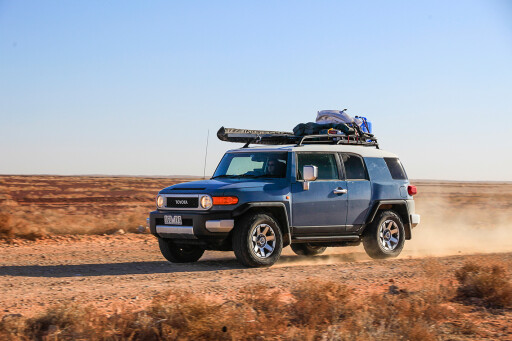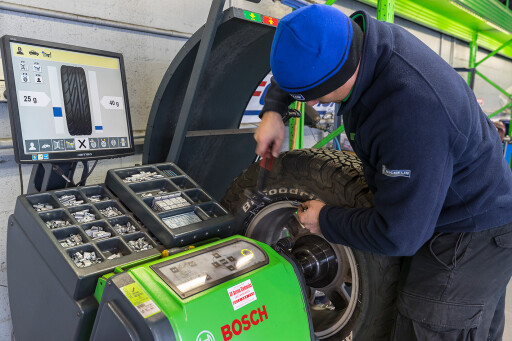.jpg )
JUST as everyone has an opinion on what tyres – and what pressures to run them at on various terrains – are best suited to a four-wheel drive, it seems many people have their own idea on the correct way to rotate the tyres to optimise longevity.
If you’re asking what we mean by tyre rotation, because, hey, they are rotating all the time when the car is moving, then let us clear that up. No matter what tyre or brand of tyre you’re using on your vehicle – and no matter how you use it – you should rotate their position on the vehicle to optimise wear rate and longevity.
Some people say you just swap them front to rear, others like to swap them side to side, and then there’s the idea of putting the spare into the rotation so you don’t end up with four worn and one unused-but-old tyre.
 So, with 10,000km on them since we fitted a set of BFGoodrich KO2s to photographer Ellen Dewar’s FJ Cruiser, and with an extensive outback trip coming up, we decided to ask the experts about the best tyre-rotation method.
So, with 10,000km on them since we fitted a set of BFGoodrich KO2s to photographer Ellen Dewar’s FJ Cruiser, and with an extensive outback trip coming up, we decided to ask the experts about the best tyre-rotation method.
These are the BFGs we had fitted to our long-term Mazda BT-50 last year, and they did around 6000km on that car before we pulled them off to give the car back. Ellen was looking for some tyres better suited to off-road use for the FJ, so, after we checked the sizing matched, we pulled them out of the shed and fitted them.
After 10,000km on the FJ we also had two unused spares to include in the rotation. Ellen also found a rivet in one of the rear tyres and, although it wasn’t losing air, we thought it should be looked at before heading bush.
BFGoodrich’s Product Marketing Manager Peter Heatley met us at the Tyres Plus store to give us an expert opinion and, to our surprise, his first piece of advice was to check the vehicle manufacturer’s recommendation.
 The FJ Cruiser Owner’s Handbook recommends tyres be rotated every 10,000km by fitting the unused spare to the near-side front wheel; the near-side front to the off-side rear wheel; the off-side rear to off-side front; the off-side front to near-side rear; and the near-side rear goes to the spare.
The FJ Cruiser Owner’s Handbook recommends tyres be rotated every 10,000km by fitting the unused spare to the near-side front wheel; the near-side front to the off-side rear wheel; the off-side rear to off-side front; the off-side front to near-side rear; and the near-side rear goes to the spare.
This is for the FJC which is a part-time 4WD, so most of the time it is operating as rear-wheel drive when it’s not off-road. As such, the rear tyres should wear more than those fitted to the front of the vehicle.
Peter Heatley backed up Toyota’s recommendation by advising to swap the rears straight to the front, with a front-to-rear crossing over the fronts when they move back. But Peter said that more important than going by the book was to inspect the tyres for wear and damage before you do anything.
“Consumers are strongly encouraged to visually inspect their tyres for cuts, trapped objects and deformations and inflation pressure on a monthly basis,” he said. “Any change in dynamic performance, such as increased air loss, noise or vibration, could be an indication of an underlying issue.”
 As expected, the inspection of the FJ’s tyres showed the rears were wearing slightly more than the fronts, while even wear around the vehicle suggested no problems with wheel alignment or suspension wear. The rivet in the near-side rear tyre was a problem however, and on removing the offending spike from the tyre it released all the air.
As expected, the inspection of the FJ’s tyres showed the rears were wearing slightly more than the fronts, while even wear around the vehicle suggested no problems with wheel alignment or suspension wear. The rivet in the near-side rear tyre was a problem however, and on removing the offending spike from the tyre it released all the air.
Being on the outside edge of the tyre tread, the puncture was deemed unsafe to repair and the tyre unserviceable. Bugger! The best rotation in this case was to fit the two as yet unused tyres to the rear wheels as they would wear faster there, and then move the off-side rear to spare.
The fronts stayed where they were and will be rotated to the rear after another 10,000km, a mark that will be coming up soon following a 3500km adventure on harsh, stony outback roads.
PRESSURE POINTS
SOMETHING a tyre technician will be looking for when inspecting tyres for wear and condition is correct pressure. Everyone has their own idea on what is right when it comes to tyre pressure, but a good place to start is with the manufacturer’s recommendation which is found on a plaque usually in a door jamb or sometimes inside the glovebox lid.
If you have changed your tyre size from the original on the vehicle placard, you should check with the tyre manufacturer – the pressure schedule for a 265/65R17 is not the same as a LT265/65R17.
 Run to these specs for normal day-to-day use and adjust to conditions; raise the pressure if you are carrying a heavy load; drop it for gravel road or harsh terrain; and drop it further for driving over sand or snow.
Run to these specs for normal day-to-day use and adjust to conditions; raise the pressure if you are carrying a heavy load; drop it for gravel road or harsh terrain; and drop it further for driving over sand or snow.
Always remember to return your tyres to spec when you get back to normal operating conditions, as this will ensure the longest possible tyre life and best ride and performance.



COMMENTS